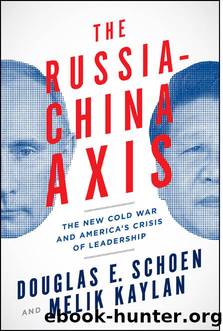The Russia-China Axis: The New Cold War and America's Crisis of Leadership by Douglas E. Schoen & Melik Kaylan

Author:Douglas E. Schoen & Melik Kaylan [Schoen, Douglas E. & Kaylan, Melik]
Language: eng
Format: epub
Tags: International Relations, Diplomacy, Political Science, World, Political Freedom, Geopolitics, Russian & Former Soviet Union
ISBN: 9781594037573
Google: q2ToBAAAQBAJ
Goodreads: 34081690
Publisher: Encounter Books
Published: 2014-09-09T00:00:00+00:00
State of the Russian Economy
âOur key challenge in the coming years is to remove many infrastructure constraints that literally stifle our country and prevent unlocking of entire regions,â said Putin as he announced a decision to tap the countryâs pension reserves for a $43 billion loan. The Russian president would use the cash infusion to pay for infrastructure projects that he hoped would pump new life into Russiaâs flagging economy.43 The plans included a superhighway in Moscow, a high-speed railway between Moscow and Kazan, and a modernization of the Trans-Siberian Railway. Critics questioned the move, suggesting that Putinâs decision would endanger pension funds and lead to inflation, not economic growthâor at least not growth anywhere near what Putin has envisioned.44
Economically, Putin has made big promises to the Russian people. On returning to power in 2012, he pledged to deliver GDP growth of at least 6 percent annually to keep Russian living standards rising steadily.45 But the IMF has cut projected Russia GDP growth to 2.5 percent in 2013 and 3.25 percent in 2014 because of âweak investment and poor external demand,â46 and Economy Minister Andrey Belousov conceded that a recession might be on the way. The Russian economic boom of 2000 to 2008 has not revived; since 2010, the economy has lagged far below the annual GDP growth target of 5â6 percent that Putin had set. Russia is unlikely to meet those targets in the future. In August 2013, Moscow announced that GDP growth in the second quarter was a paltry 1.2 percent. Putinâs critics pounced.
âI donât really think the economy is heading toward collapse, more likely long-term stagnationâa lost decade, if you will,â said Vladimir Milov, a former deputy energy minister and now a leader in the political opposition. âThis will not lead to an immediate surge in protests, but it will be very difficult for Mr. Putin to stage another successful election in 2018 should the economy be dead.â47
Putin is doing everything he can to prove Milov wrong, and the Russian economy does retain some powerful advantages. Russia straddles two vastly different regions and has a different economic position relative to each. Per capita, Russia is about as wealthy as most of its central Asian, Eastern European, and Asian neighbors, but because of its size, it has a vastly higher GDP than any of these countries: over $2 trillion in 2011.48 With no legitimate rival peers in the region, Russia enjoys huge economic leverage over its relatively weak neighbors. And Russia is trying to expand its economic trade in the Asia-Pacific region, currently about a quarter of its national total (the EU remains Russiaâs biggest trading partner). Russiaâs Asia-Pacific position is strong in two areas: It is the sole petroleum-exporting region in the trading bloc, and it possesses nuclear expertise unmatched by any other Asian Pacific Economic Cooperation (APEC) nation.49
Russia has pursued economic expansion through smart use of plentiful natural resources, predominately in oil and energy. Russia leads the world in natural-gas production, generating 20 percent of global
Download
This site does not store any files on its server. We only index and link to content provided by other sites. Please contact the content providers to delete copyright contents if any and email us, we'll remove relevant links or contents immediately.
| Arms Control | Diplomacy |
| Security | Trades & Tariffs |
| Treaties | African |
| Asian | Australian & Oceanian |
| Canadian | Caribbean & Latin American |
| European | Middle Eastern |
| Russian & Former Soviet Union |
The Secret History by Donna Tartt(18188)
The Social Justice Warrior Handbook by Lisa De Pasquale(11957)
Thirteen Reasons Why by Jay Asher(8461)
This Is How You Lose Her by Junot Diaz(6452)
Weapons of Math Destruction by Cathy O'Neil(5842)
Zero to One by Peter Thiel(5498)
Beartown by Fredrik Backman(5369)
The Myth of the Strong Leader by Archie Brown(5243)
The Fire Next Time by James Baldwin(5024)
How Democracies Die by Steven Levitsky & Daniel Ziblatt(4966)
Promise Me, Dad by Joe Biden(4912)
Stone's Rules by Roger Stone(4867)
100 Deadly Skills by Clint Emerson(4695)
A Higher Loyalty: Truth, Lies, and Leadership by James Comey(4557)
Rise and Kill First by Ronen Bergman(4548)
Secrecy World by Jake Bernstein(4394)
The David Icke Guide to the Global Conspiracy (and how to end it) by David Icke(4386)
The Farm by Tom Rob Smith(4329)
The Doomsday Machine by Daniel Ellsberg(4250)
